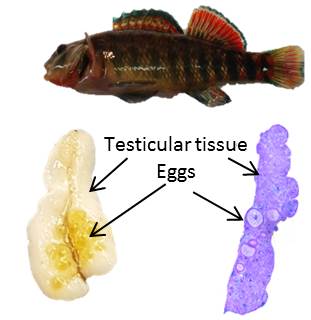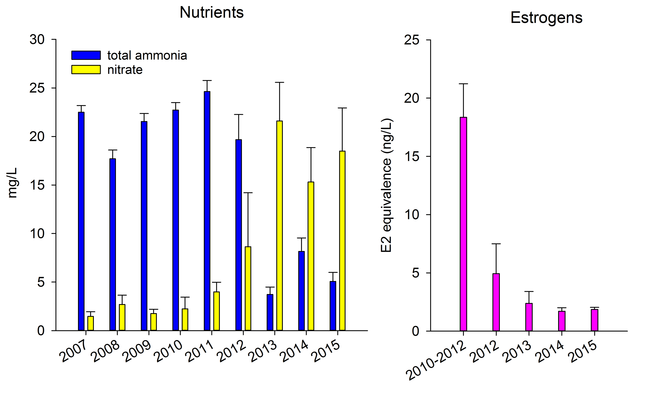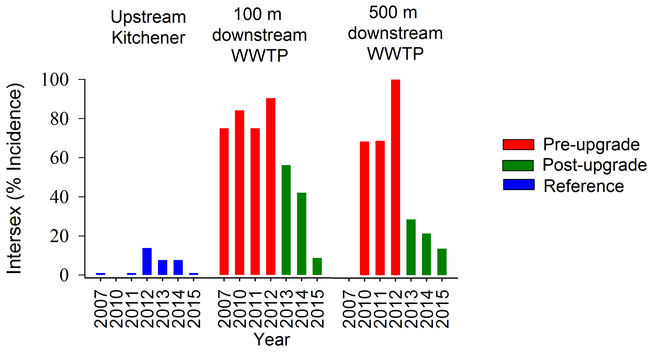Introduction
The continued urbanization of human populations is increasing demands on our limited water resources. Management and treatment of water and wastewater is currently a national and global challenge, and will be into the foreseeable future. Despite the abundance of water in Canada, the distribution of populations and water resources put some watersheds at risk. Municipal wastewater is the largest point-source of effluent in the country with more than 3,500 wastewater treatment facilities that vary in design, processes and size. Despite massive public investment in wastewater infrastructure over the past few decades, major concerns related to the environmental impacts of municipal wastewater effluents remain, especially with regard to emerging contaminants of concern such as pharmaceuticals and endocrine disruptors. Interest in the endocrine disrupting effects of wastewater was sparked by observations that fish downstream of wastewater outfalls exhibited reproductive changes including a high incidence of intersex, where male fish developed eggs in reproductive tissue (Figure 1). Since these early observations, numerous reports worldwide have associated wastewater exposure to the increased occurrence of intersex in fish, including recent studies in the Grand River, Ontario. Fish with moderate levels of intersex severity (only a few oocytes in the testes) are capable of producing progeny, while fish with high intersex severity (presence of many and more mature oocytes) have been associated with impaired reproductive capacity. The significance of having severely intersex males in a population of fish remains ambiguous.

Figure 1. Intersex (oocytes in testes) in rainbow darter.
Methodology
The presence of intersex fish downstream of municipal wastewater effluent discharges has been associated with the presence of estrogen agonists in the effluents. These are chemicals that can bind and activate the estrogen receptor. Numerous laboratory experiments have demonstrated that estrogenic chemicals found in municipal effluents such as the active ingredient in birth control pills, 17α-ethynylestradiol (EE2), can disrupt egg production in female fish and cause the development of female traits in male and developing fish. Although the European Union has recently proposed environmental quality standards for 17β-estradiol (E2) of only 0.4 ng/L and for EE2 only 0.035 ng/L, the predicted concentrations in many Canadian wastewater effluents are much higher. Despite the clear relationship between estrogen exposure and reduced reproductive capacity in controlled experiments, the linkage between the many endocrine disrupting compounds detected in effluents and effects in the field has been difficult to establish. In this study, this link is examined based on real field data.
Outcomes
Recent work in the Grand River watershed has demonstrated that a variety of estrogens, antiandrogens, and pharmaceuticals are associated with the effluents flowing into the river. This pattern is related to the degree of wastewater treatment, in particular the degree of nitrification. We have predicted and measured the total estrogenicity based on bioassays expressed as 17β-estradiol equivalents (E2-Eq) in poorly treated (non-nitrifying) effluents at levels far exceeding the thresholds for reproductive effects in fish (Figure 2). Subsequent field studies have demonstrated effects in fish associated with wastewater exposure in the Grand River. A wild sentinel fish species, the rainbow darter (Etheostoma caeruleum), exposed to poorly treated effluents has shown changes in gene expression, an impaired ability to respond to stress, as well as changes in physiological endpoints such as sex steroid production capacity. The most consistent response has been the very high occurrence of intersex in fish downstream of the municipal effluent outfalls, with 70-100% of the males collected downstream of the Kitchener Wastewater Treatment Plant outfall (prior to 2013) having oocytes in their testes. Some of these fish contained macroscopic vitellogenic oocytes developing in the testes, that is, visible eggs in male tissue (Figure 1). These responses have been associated with changes in reproductive endpoints including reduced steroid production (especially androgens, for example testosterone), reduced secondary sex characteristics, and altered energy storage that may lead to impaired reproductive performance. This could influence fish communities that also appear to be altered downstream of effluent outfalls. The significance of these changes in the Grand River, including the high incidence of intersex, is still unclear, but suggests that poorly treated municipal effluents were impairing the reproductive performance of these fish.

Figure 2. Changes in ammonia/nitrate and total estrogenicity in the Kitchener Wastewater Treatment Plant effluents.
Conclusions
In late 2012, the Region of Waterloo implemented a series of major infrastructure upgrades at the Kitchener Wastewater Treatment Plant that included additional aeration to achieve greater nitrification that greatly improved effluent quality (Figure 2). Although these upgrades were targeted at traditional effluent quality endpoints (e.g. ammonia, total suspended solids) a large drop in total estrogenicity resulted as well. There was a dramatic reduction in the incidence and severity of intersex in the rainbow darter collected downstream in the following year (Figure 3). A concurrent change in gene expression and a recovery of the ability of these fish to produce reproductive steroids including 11-ketotestosterone, the main androgen in rainbow darter, was also observed. Although a low incidence of intersex remains, exposure modelling suggests that these residual effects may be partly due to the influence of upstream inputs from the Waterloo treatment plant which was not upgraded in a similar way until the summer of 2017.

Figure 3. The rapid decline in intersex in rainbow darter response to wastewater treatment plant upgrades.
Continued studies in the river are exploring if upgrades to the Waterloo plant, and continued upgrades to the Kitchener plant, will further reduce contaminant exposure in the receiving environment and lead to additional improvements in fish health. The rapid recovery in key fish responses, including intersex, is promising and suggests that (secondary) treatment upgrades aimed at achieving the targets in the Fisheries Act regulations will be effective at removing the major adverse responses associated with endocrine active chemicals in municipal wastewater. Considering the enormous public expenditures involved in wastewater infrastructure, it is reassuring to confirm that these investments are having positive impacts on improving the health and resiliency of our rivers.
Hicks, K.A., E.L. McCann, M.K.M. Fuzzen, L. Bragg, S. Kleywegt, G.R. Tetreault, M.E. McMaster, and M.R. Servos (2017). Rapid reduction of intersex in a wild fish population in response to major municipal wastewater treatment plant upgrades. Environmental Science and Technology 51(3), 1811–1819.
Contact: Mark Servos, Department of Biology; Keegan Hicks, Biology; Patricija Marjan, Biology
For more information about the Water Institute, contact Amy Geddes.








